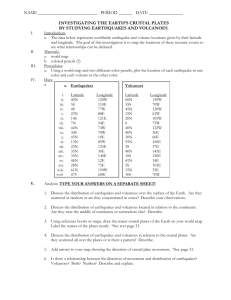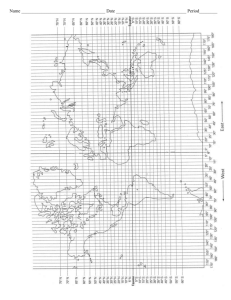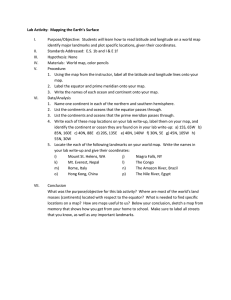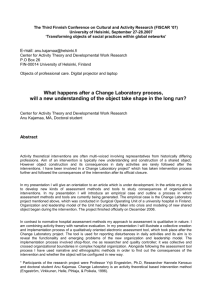COORDINATION OF EARTH STATIONS WITH RESPECT TO TERRESTRIAL STATIONS /
advertisement
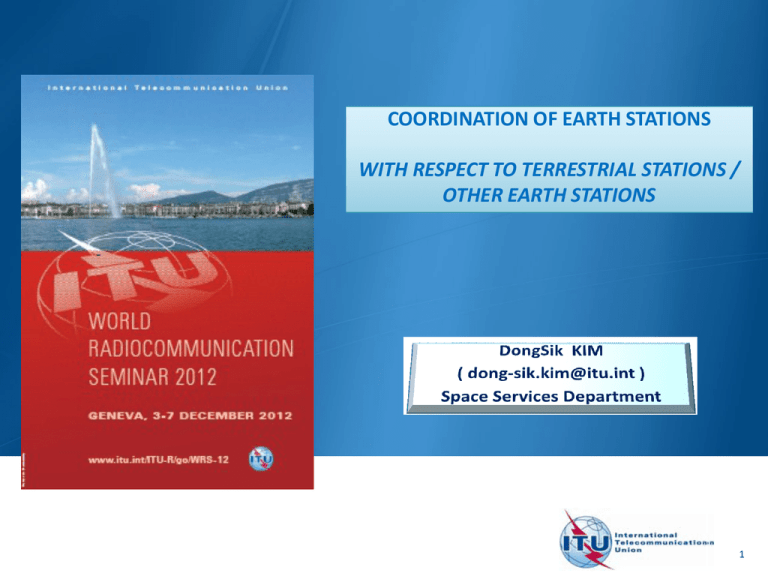
COORDINATION OF EARTH STATIONS WITH RESPECT TO TERRESTRIAL STATIONS / OTHER EARTH STATIONS 1 Coordination requirements GSO Satellites Non-GSO Satellites Transmitting Earth Station Interference Terrestrial Receiving Earth Station Why ? COORDINATION OF EARTH STATIONS Volume No.1 Article 5 Article 9 Region 1 ___________________ 5850 - 5925 MHz All Regions ___________________ 6700 - 7075 MHz FIXED FIXED-SATELLITE (Earth-to-space) ↑ MOBILE FIXED FIXED-SATELLITE (Earth-to-space) ↑ (space-to-Earth) ↓ MOBILE Provisions : 9.6, 9.15, 9.17, 9.17A, 9.21 Volume No.2 Appendix 7 Appendix 5 Coordination area : Appendix 4 Coordination data to neighboring countries (Vol. 1) Article 11 Notification in Master Register When ? Volumn No.1 Article 5 Region 1 ___________________ 5850 - 5925 MHz FIXED FIXED-SATELLITE (Earth-to-space) ↑ equal rights Space = Terrestrial All Regions ___________________ 6700 - 7075 MHz FIXED-SATELLITE (Earth-to-space) ↑ (space-to-Earth) ↓ opposite direction Uplink = Downlink • If coordination area includes the territory of another country PROVISIONS for effecting COORDINATION 9.6 9.11A/ 9.15 Article 9 9.17 Administrations shall effect coordination before notifying to the BR or brings into use any frequency assignment. Coordination of a Specific or Typical Earth Station of non-GSO in respect of Terrestrial Stations (associated with Footnote - 9.11A) Coordination of any Specific Earth Station or Typical Mobile Earth Station in frequency bands above 100 MHz, in respect of Terrestrial Stations, with the exception of the coordination under 9.15 9.17A Coordination of any Specific Earth Station in respect of other Earth Stations operating in the opposite direction of transmission (ODT), or any Typical Mobile Earth Station in respect of Specific Earth Station (ODT) *Rx E/S – No methodology in AP7 9.21 Specific Earth Station of a service required to seek agreement of other administrations (under Footnotes) Why AP7? AP7 Anomalous (short-term) Interference Propagation mechanisms Common Volume at the intersection of the antenna main beams Elevated layer reflection/refraction (h < x 100m) Hydrometeor scatter Tropospheric scatter (>100km) Ducting (>500km) Diffraction (local) Great-circle propagation (Mode 1) – 4 Radio-Clim. zone + Hydrometeor scatter (Mode 2) – 15 Rain zone A-Q Simple button? Computer Program for Determination of Coordination Area AP7 embedded in GIBC C:\BR_SOFT\BATCH Create your Input File Report (p1) of AP7 (GIBC) program Rcv GSO ES (FSS) w.r.t. Terrestrial St (TS, FS, MS) Freq: 3850-4200 GHz Sat longitude : 18 W Horizon Ele. Anagle : 0 Affected countries: Countries included in Coordination Distance/Area Automatic indication in AP7 report Report (p2) of AP7 (GIBC) program Tech. parameters of the planning E/S Calculated parameters by 5° Azimuth Coordination distance by 5° Azimuth ( 0 - 355º ) Probably Affected ADM in AP7 report How (Tx E/S)? Azimuth xo Max ( Great-circle propagation Hydrometeor scatter (Mode 2) (Mode 1) , (Mode1) L(%)=Pt+Ge+Gx-Pr(%) ex: Gx = 52 dBi, Pr(0.0025%) = -98 dBW/Hz for 12-14GHz L(%)=Pt+Gx-Pr(%) (Mode2) AP7 Table 7 Hydrometeor scatter Great-circle propagation Gx Pr(p) ) Gx Pt * Ge (10 to 123 Km/f) Minimum Coordination Distance Maximum Calculation Distance (369/ Mode2 up to 1200 Km/ Mode1*Zone C) Coordination area of Tx GSO E/S (FSS) with respect to Rcv Terrestrial stations (FS) 15E 20E ALB 10E 40N 40N MLT 35N 35N Freq: 5925 - 6425 GHz Sat longitude : 1 W Horizon Ele. Anagle : 0 Affected countries: I LBY TUN 20E How (Rcv E/S)? Azimuth xo Max ( ) (Mode1) L(%)=Pt+Ge+Gx-Pr(%) ex: Gx = 45 dBi, Pt= -3 dBW, p(0.0015%) for 10-12.75GHz AP7 Table 8 Great-circle propagation Hydrometeor scatter (Mode 2) (Mode 1) , L(%)=Pt+Gx-Pr(%) (Mode2) Hydrometeor scatter Pt * Gx Pr(p) Ge (10 to 123 Km/f) Minimum Coordination Distance Maximum Calculation Distance (369/ Mode2 up to 1200 Km/ Mode1*Zone C) Coordination area of Rcv GSO ES (FSS) with respect to Tx Terrestrial stations (FS) 5E 10E 15E 20E SRB SMR MCO 25E BUL MNE CVA I 40N ALB MKD 40N GRC MLT 35N 35N TUN Freq: 3700 - 4200 GHz LBY Sat longitude : 1 W 30N 30N Horizon Ele. Anagle : 0 Affected countries: ALB GRC I LBY TUN 5E 10E 15E 20E Contour of Opposite direction 1 Appendix 7 - Annex 3 & 5 + Table 9 Worst Case Scenario (for Rx E/S) • Horizon ele. angle (Rx E/S) = 0 ° • Orbit inclination = 0 ° • Anywhere in GSO orbit (> εmin ) • Same latitude with Tx E/S • Find Min. separation Angle of Rx E/S (for Azimuths) • Calculate Distance with Off Axis Rx Gain AP7 Table 9 TRANSMITTING EARTH STATION Min. Separation Angle + Off Axis Rx Gain Receiving Earth Station Contour of Opposite direction 2 Appendix 7 - Annex 5 + Table 9 Worst Case Scenario (as Mode1) + • Plane geometry approximation • Rx E/S operates at Min. Ele. angle • Beam intersection under Rain height Apply Geometrical construction • Min. Coor. Distance (for some Azimuths) • two 6° sectors => worst-case distance No auxiliary contours (No calculation) N - αw 3° 3° demax αw hR demax 3° 3° ds Tx E/S • hR : rain height • ds : horizontal distance • αw : Azimuth to possible Rx E/S (by Latitudes, εmin) • demax : Max calculation distance by hR Coordination area of Tx GSO ES (FSS) with respect to Rcv GSO ES (EESS) Freq: 8025-8350 GHz Sat longitude : 1 W Horizon Ele. Anagle : 0 Affected countries: I TUN Coordination area of Tx NGSO ES (FSS) with respect to Rcv GSO ES (EESS) 0 5E 50N 10E 50N LUX Earth station (NGSO) No Mode2 contours D Tracking Antenna reduce the probability of Mode2. SUI F LIE I 45N 45N Main Mode 1 SMR MCO Aux. Mode 1 AND 0 5E 10E Coordination Area of Mobile Earth Stations For a mobile earth station, the periphery of the service area is extended by the coordination distance (calculated or predetermined). Calculated . . . . . . . . . Mobile Earth Station Service Area . . . . .. . . Coordination Area Predetermined Coordination distance (Table 10 of Appendix 7) AP7 Table 10 Predetermined Typical, 100Km 125E (Example Adm: KOR) Typical, 400Km 130E 120E 125E 130E Typical, 580Km Typical, 500Km 135E 115E 120E 125E 130E 135E 140E 115E 120E 125E 130E 135E 140E 45N 40N 45N 40N KRE 40N 40N KRE 40N 40N KRE 40N 40N KRE KOR J KOR 35N 35N J KOR 35N KOR 35N 35N 35N 35N 35N J CHN CHN J 30N 30N 125E 130E 120E Typical, 1000Km 105E 110E 115E 120E 125E 130E 135E 140E 125E 130E 135E 120E 45N 105E 150E 110E 115E 120E 125E 130E 135E 140E 145E 125E 130E 135E 120E Specific, 100Km Typical, 1080Km 145E 30N 30N 30N 30N 125E 150E 45N 45N 45N 40N 40N 40N KRE 120E 125E 130E 135E KRE KRE 40N KRE J KOR 35N 135E 40N 40N 40N 130E Specific, 580Km 130E 40N 125E 35N 35N J KOR 35N KOR CHN 30N 30N CHN 30N 30N 25N 25N KOR 35N 35N 25N J 25N MACHKG MACHKG 115E 20N 120E 125E 130E 135E 140E 20N 115E 120E 125E 130E 135E 140E 125E 130E 120E 125E 130E APPENDIX 7 Definition of the Coordination Area 0 315 45 SVK D Coordination contours with the greatest coordination distance AUT SUI HNG F SVN ROU HRV I BIH YUG However BUL E MKD ALB GRC 270 TUR It represents a regulatory concept based on Worst Cases & Conservative Assumptions. 90 MLT TUN i.e. ALG EGY Mode(1) Mode(2) 225 It’s not a exclusion zone. LBY means 180 135 More detailed calculations and discussions need to be performed. Coordination data (Appendix 4) Annex 2 GEOGRAPHICAL DATA (Earth station’s) Location, Altitude SATELLITE Orbital Location, Identification (Geo, Non-Geo) ANTENNA Maximum gain Radiation pattern SIGNAL CHARACTERISTICS Power Maximum Power Density Frequencies Noise temperature Emission Type Others Horizontal Elevation Angle Horizontal Elevation Angles • All Azimuths around Earth Station Ant. • if no values between Average value Azimuth x5 • No values default 0 degree . .. Azimuth x4 o o Azimuth x2 o Azimuth x o . Azimuth x 3o HE Angle 4 HE 2 HE Angle 5 AngleElevation Horizon HE Angle 3 Angle 1 Angle HE Earth station . Azimuth x1 o Effect of Horizon Elevation Angle RECEIVING EARTH STATION COORDINATION AREAS MAGHTAB MLT/MLT 014E2640 35N5556 SVK D AUT F UKR HNG F ROU SVN I BIH AUT SUI HRV SVK D HNG SUI SVN MDA 4135.0 - 4135.0 MHZ I BIH YUG YUG BUL E ROU HRV BUL E MKD MKD ALB ALB GRC TUR GRC TUR MLT MLT TUN TUN ALG ALG EGY EGY LBY HORIZON ELEVATION ANGLE : 0 o LBY Reduced Coordination Area HORIZON ELEVATION ANGLE: Actual Value Tips for Coordination ? More practical consideration on the Coordination Area AP7 embedded in GIBC Auxiliary Contour Extra coordination lines inside main contour It’s all Complementary information. Auxiliary Contour - Mode 1 (& 2) Appendix 7 - Annex 6 Extra coordination lines inside main contour (decided between ADMs) Country - 10 dB Auxiliary contour Coordination contour (Gx = - 40 dBW) (Gx=50 dBi) Country A B - 5 dB Auxiliary contour (Gx = 45 dBi) Auxiliary Contour - Mode 1 HRV Auxiliary Contour I 45N 45N (ex. -5,-10,-15 dB) BIH MCO SMR Mode 1 CVA 40N 40N Auxiliary Contour - Mode 2 Appendix 7 - Annex 6 (from WRC-2000) Beam Avoidance Angle = X° Protection Angle Critical Angle Earth Station Extra coordination lines inside main contour (decided between ADMs) HO L Auxiliary Contour - Mode 2 BE L LUX 50N 50N SUI F 0 5E Response by Administration B (to Coordination Request from A) A Coordination Request • AP4 Annex2 Data • AP7 Contours Technical Examination • Collect existing and planned system in 3 years • Inside Coordination Contours Acknowledge of receipt Notification for Adm B’s system •TS+ES(ODT) in 3 years Bringing into use Disagreement (Art 9.52) • Adm B’s assignment • Suggestion for resolution Notification for Adm B’s system •Bringing into use – TS in 3 Months ES(ODT) in 3 years ITU B A Agreement (Art. 9.52B) •Inclusion of B’s systems into use in 3 years Administration Administration 4 Months Request additional Info. (if it is necessary ) Result of WRC-12 No major change in AP7 • Some frequencies/services were deleted/added in Table 7 – 9. • It’s consequential arrangement with regards to Art 5 & footnotes. 3 Things to Do on Coordination of Earth Stations Question ? Answer ! if
